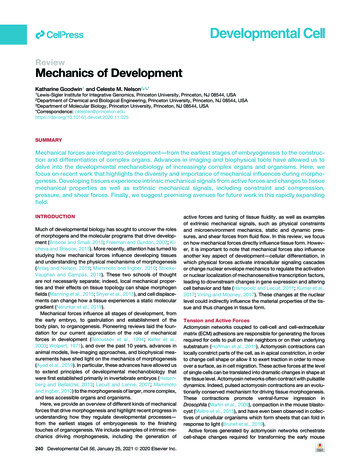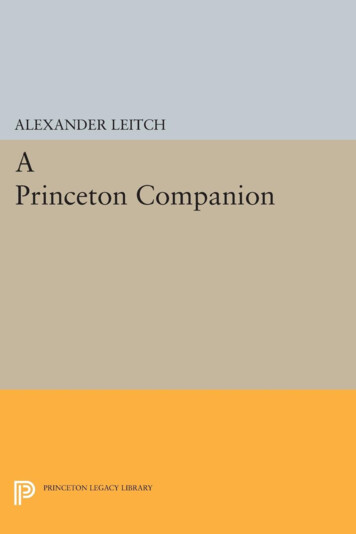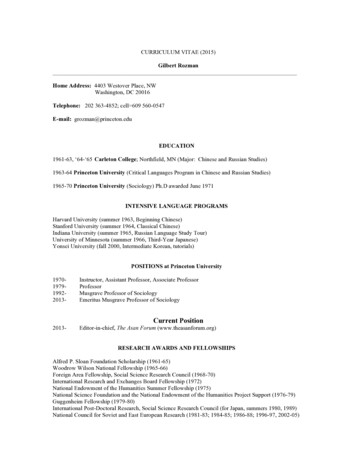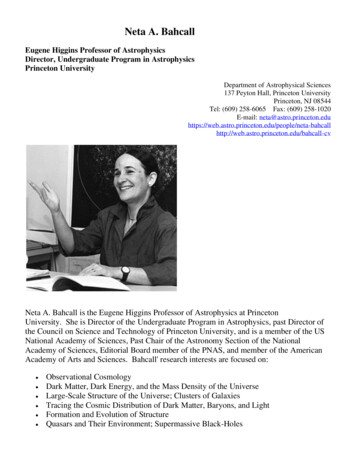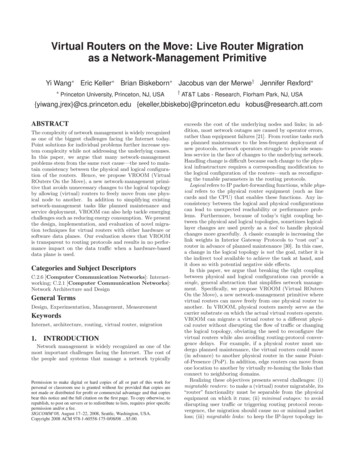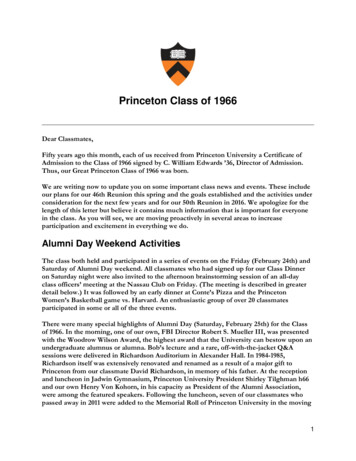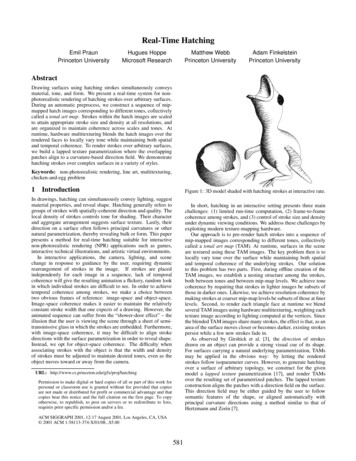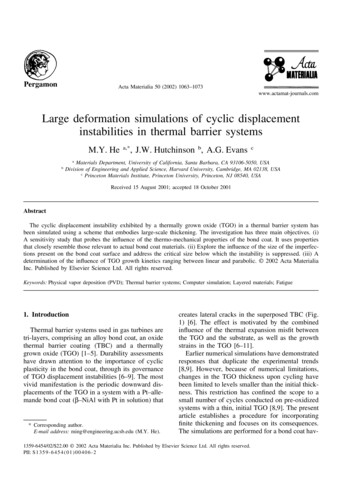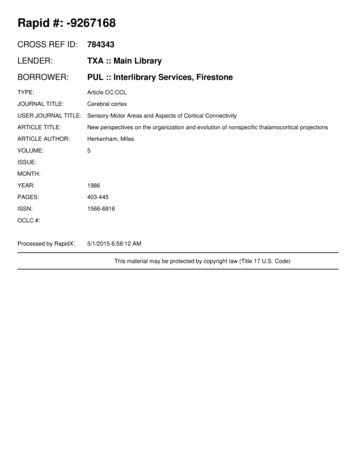
Transcription
Rapid #: -9267168CROSS REF ID:784343LENDER:TXA :: Main LibraryBORROWER:PUL :: Interlibrary Services, FirestoneTYPE:Article CC:CCLJOURNAL TITLE:Cerebral cortexUSER JOURNAL TITLE: Sensory-Motor Areas and Aspects of Cortical ConnectivityARTICLE TITLE:New perspectives on the organization and evolution of nonspecific thalamocortical projectionsARTICLE AUTHOR:Herkenham, N:1566-6816OCLC #:Processed by RapidX:5/1/2015 6:58:12 AMThis material may be protected by copyright law (Title 17 U.S. Code)
New Perspectives on theOrganization andEvolution of NonspecificThalamocorticalProjections11MILES HERKENHAM1.Historical Origins of the Term "Nonspecific Thalamus"Lorente de N 6 (1938) provided the classic description of two contrasting thalamicafferent fiber types in the rodent neocortex. His Golgi material showed "specific"fibers, which arborize densely in very restricted cortical domains, and "unspecific" fibers, which distribute sparsely across large cortical expanses. These initialanatomical observations were embraced by electrophysiologists who electricallystimulated thalamic nuclei in cats and recorded two fundamentally differentkinds of cortical response, depending on the locus of stimulation. "Specific" and"nonspecific" thalamic nuclei were named according to their ability to elicitrestricted cortical "augmenting" or widespread "recruiting" responses, respectively (Morison and Dempsey, 1942; Dempsey and Morison, 1942b). During the1940s and 1950s a consensus took hold-that the specific system defined anaMILES HERKENHAM Laboratory of Neurophysiology, National Institute of Mental Health,Bethesda, Maryland 20892.403E. G. Jones et al. (eds.), Sensory-Motor Areas and Aspects of Cortical Connectivity Plenum Press, New York 1986
404tomically was the same as that defined electrophysiologically and, likewise, thatthe unspecific axons in cortex are the substrate for recruiting evoked in widespread areas and, therefore, arise from the nonspecific nuclei.The differentiation between augmenting and recruiting responses becamethe basis for more than two decades of investigation. The augmenting responsewas evoked by repetitive low-frequency stimulation of the main sensory relaynuclei, among others, and was recorded only in restricted cortical areas whoseloci varied with the thalamic site of stimulation (Morison and Dempsey, 1942;Dempsey and Morison, 1942b). A biphasic (positive-negative) "primary" response appeared upon the first stimulus presentation, was "augmented" by repetition, and then followed repetitive stimulation with short latencies.In contrast, the monophasic (negative at the cortical surface) recruitingresponse was evoked by 6- to 12-Hz stimulation of intralaminar and certainadjacent thalamic nuclei (Fig. 1) and appeared over widespread cortical areas.CHAPTER 11 7S.3'2.,0I0,3)Figure 1. The location of the physiologically defined nonspecific thalamus displayed at four coronal levels of the catbrain. Stipples mark sites where low-frequency (6-12 Hz)electrical stimulation produces recruiting responses in thecortex. The double stippling in medial V A (at Fr. 12.0) marksthe location where low-intensity stimulation elicits recruitingat widely dispersed cortical recording sites. Most of the abbreviations are given in the text. Reproduced with permission from Jasper (1961).
The response typically did not appear after the first shock but increased tomaximum amplitude after about three stimulus presentations (hence the namerecruiting) and showed long latencies (10-30 msec).The thalamic nuclei which produced the recruiting phenomenon when stimulated were found to be clustered in and around the internal medullary laminaor at the rostral pole of the thalamus (Fig. 1). They included midline nuclei(reuniens, rhomboid, centralis medialis), the intralaminar nuclei (paracentral,central lateral, and, posteriorly, the para fascicular and centre median nuclei),the thalamic reticular nucleus (especially at the rostral pole), and nuclei adjacentto the internal medullary lamina (ventroanterior, ventromedial, submedius, paralaminar parts of the mediodorsal and anteromedial, suprageniculate, and limitans). Because of widespread (diffuse) cortical responses to their stimulation,these nuclei were collectively termed the nonspecific thalamus.The nonspecific thalamus attracted much attention because of its apparentfunctional significance as a potential center for controlling physiological andbehavioral levels of arousal, and even consciousness itself. Penfield (1954) proposed the existence of a subcortical "centrencephalic" system capable of generating bilateral cortical wave-and-spike patterns in certain petit mal epilepsies.The additional observations that electrical alterations in different cortical areasoften occur concurrently, and that the wave-and-spike pattern can be producedby nonspecific thalamic stimulation, supported the view of a thalamic pacemakerof cortical activity (reviewed in Krupp and Monnier, 1966). Furthermore, it wasfound that the cortical distribution, waveform properties, and waxing and waning of the amplitude of the recruiting response were similar to those of "spindles"emitted during a synchronous EEG state associated with drowsiness or inattention in animals (Morison and Dempsey, 1942; Phillips et aI., 1972). By contrast,when stimulated with high-frequency pulses ( 60 Hz), the nonspecific nucleicould also produce widespread de synchronization of cortical activity (Dempseyand Morison, 1942a; Moruzzi and Magoun, 1949), an EEG state associated witharousal and vigilance (Steriade, 1981).Although the initial observations suggested a promising future for studiesof nonspecific thalamocortical function, subsequent research failed to revealthose functional bases. As anatomical and physiological scrutiny grew more intense, the hypothesis that all nonspecific nuclei had connectional and functionalsimilarities became untenable. For example, it was discovered that the thalamicreticular nucleus does not project to cortex at all (Scheibel and Scheibel, 1966;Jones, 1975b) and that stimulation of the ventroanterior or ventrolateral nuclei,but not of certain other nuclei, evoked both augmenting and recruiting responsesin different cortical regions (Jasper, 1961; Sasaki et aI., 1970). Even the dichotomy of augmenting and recruiting was questioned (Schlag and Villablanca, 1967).Gradually, the focus of research was shifted to other areas. Nowadays, manyresearchers consider the nonspecific thalamus to be just a vague construct.Hopefully, however, a number of recent anatomical findings may rekindlean interest in nonspecific thalamocortical organization and function. Althoughnew physiological data are scarce, a wealth of relevant connectional data fromaxoplasmic transport studies has accumulated in the past decade. The remainderof this chapter will be devoted to a presentation and review of the anatomicalbases for thalamocortical organization. A new organizational scheme will bepresented which does not conform to the earlier two-part division of the thalamus405NONSPECIFICTHALAMO-CORTICALPROJECTIONS
406CHAPTER 11but which does help to resolve the aforementioned difficulties with the simpledichotomy of specific and nonspecific systems.Anatomical evidence to be presented in this chapter introduces a tripartitegrouping of thalamic nuclei. The grouping is based on the lamination patternsof thalamic axons in rat cortex. The laminar patterns will be correlated withother features of axon distributions (e.g., restricted versus widespread), and theywill be discussed from functional and comparative points of view.2.A Tripartite Division of Thalamus Based on CorticalLayers of TerminationA scheme that has proven useful for classifying thalamic nuclei is based onthe lamination patterns of their cortical projections in the rat (Herkenham,1980a,b). The lamination patterns can be grouped into three classes; hence, socan the thalamic nuclei of origin. One class, which contains the specific nuclei,is well known. Details of the second and third classes have often been confused;the present clarification is based on studies employing the anterograde flow oftritiated amino acids in the rat. These data appear in several publications (Herkenham, 1978b, 1979, 1980a) and in this chapter. See also the chapters by Jonesand White in this volume and others in Volumes 3 and 4 of this treatise.The first class includes the thalamic relay nuclei for vision, audition, andsomesthesis. The cortical projections terminate mainly in layer IV, layer III, orboth. The fibers in this class correspond to the traditionally defined specificcortical afferent fibers (Lorente de No, 1938). The second class includes theintralaminar and thalamic paraventricular nuclei, which project to deep corticallayers (layer V, VI, or both). The third class comprises an assortment of nucleithat share a pattern of dense, widespread projections to layer I, though terminations in other layers mayor may not be present. These layer I-projectingnuclei generally occupy a position adjacent to the intralaminar nuclei. Hence,they also will be referred to as the "paralaminar" nuclei, a term previously usedto denote only portions of the present collection comprising the third class (N autaand Whitlock, 1954; Rieck and Carey, 1982b,c). The three classes of nuclei areillustrated in Fig. 2.Although the classification scheme is based on laminar distribution patterns,it is noteworthy that the projections of the first class have restricted areal extents,whereas those of the second and third classes appear to span widespread areasof cortex. Therefore, the areal distributions of fibers of the second and thirdclasses make both classes likely candidates for inclusion in the physiologicallydefined nonspecific thalamus. The match is not perfect, however. The nonspecific nuclei of the earlier, physiological scheme (Fig. 1) include the followingnuclei of the present, anatomical scheme (Fig. 2): the paralaminar mediodorsalnucleus of the first class, the intralaminar nuclei of the second class, and severalparalaminar nuclei of the third class. The reticular nucleus, an important component of the physiologically defined nonspecific thalamus, is not included inany of the three current classes because it lacks cortical projections.The remainder of Section 2 will provide anatomical details of the tripartiteorganization of the rat thalamus. Most of the focus of this section and the
remainder of the chapter will be on the third class of fibers, the layer I -projectingclass, for several reasons. First, the initial description of the "unspecific" fibertype in cortex by Lorente de No (1938) indicated that layer I was the predominantlayer of termination of the putative diffuse thalamic projection system. Closelytied to this point is the second point, that the recruiting response was commonlybelieved to be generated by synaptic events occurring initially in layer I (Li etat., 1956; Spencer and Brookhart, 1961). Third, a major goal of this chapter isto dispel a generally held view that the intralaminar system is the main thalamicorigin of layer I projections, presenting anatomical evidence for the distinctionbetween intralaminar (deep layer projecting) and paralaminar (layer I projecting)nuclei, and then arguing that these two systems might contribute to corticalfunction, particularly in relation to the recruiting response and diffuse thalamocortical physiology.2.1.Specific NucleiCharacteristics of the nuclei of origin and the dense arborizations of specificthalamocortical fibers in layers III/IV have been described in detail elsewhere(see White, this volume) and will not be discussed here.2.2.Nonspecific Deep Layer-Projecting NucleiFibers of the second class project mainly to deep cortical layers. Intralaminarnuclei are the main source of these fibers in the rat. The intralaminar system isFigure 2. Drawings of two thalamic levels inthe rat, showing a tripartite division based onthe laminar patterns of terminations of thalamocortical projections. Hatched and shadedareas mark nuclei which have been shown byautoradiography of anterogradely transported tritiated amino acids to have projections directed predominantly to superficial,intermediate, or deep cortical layers. The blackdots show the locations of retrogradely labeled neurons in a case in which HRP wasinfused into layer I of somatosensory cortex(Herkenham and Moon Edley, unpublished).Note that the cells are found only in areasthat project to layer I according to the autoradiography. pc, paracentral; po, posterior;vi, ventrolateral; vm, ventromedial; vp, ventroposterior nuclei. Reproduced from Herken ham (198Gb).layer V!VIlayer IT407NONSPECIFICTHALAMOCORTICALPROJECTIONS
408CHAPTER 11the subject of Macchi and Bentivoglio's contribution in this volume and so onlythe salient features will be presented here.2.2.1.Intralaminar EfferentsTritiated amino acids, iontophoretically delivered in very small amounts tothe intralaminar (central lateral, paracentral, central medial), parafascicular, andparaventricular nuclei in the rat, label sparse but widespread projections to deeplayers of neocortex. Two examples will illustrate the general features of thissystem. The central medial nucleus (CeM) is a relatively large, cytoarchitecturallydistinct nucleus, making possible a relatively confined injection (Figs. 3d, 4).CeMFigure 3. Drawings of coronal levels in the rat, showingdistribution of labeled fibers arising from the midline intralaminar nucleus, CeM (central medial nucleus). Labeled fibers and terminals are represented by small dots arrangedto resemble how they appeared under microscopic examination. The main projection targets are the cau-date-putamen (b-d) and layers V and VI of nearly the entirecerebral cortex. In this and subsequent drawings, solid linesin the cortex indicate the layer IIII boundary and the upperand lower boundaries of layer V. Details of this projectionare given in the text. Case RRCeM-13, 18 weeks' exposureto the emulsion.
Tracer placed rostrally in CeM labels projections to layer V and/or VI in virtuallythe entire cerebral cortex (Fig. 3). Labeled CeM axons pass through the ventrorostral part of the reticular nucleus and issue collaterals that terminate denselythere (Fig. 3c). Most axons reach the striatum, in which they terminate or enterthe subcortical white matter and deep layers of cortex (Fig. 3b,c). CeM fibers infrontal cortex terminate in layers V and VI (Fig. 3a). A small number of fibersascends to layer I of the medial frontal and sulcal areas (Fig. 3a). In parietal(Figs. 3b-d, 4) and occipital (Fig. 3e,f) areas, labeled fibers run long distanceswithin layer VI.Injections placed elsewhere in the intralaminar complex reveal projectionswith more limited areal extents. Figure 4 shows the sparse distribution oflabeledfibers in layers V and VI of parietal cortex after a small deposit was placed inthe paracentral (Pc) nucleus. Further details of the distributions and topographyof intralaminar projections have been summarized (Herkenham, 1978a, 1980a).2.3.Nonspecific Layer I-Projecting Nuclei: The Paralaminar SystemThe third class of thalamocortical axons arises from five to ten nuclei in therat, depending on whether nuclei with projections to juxtallocortical structuresare included. Most of these nuclei are paralaminar in location, but their cardinalfeature is that they all have in common a dense projection to layer I. There isno representative member of this class because most nuclei project additionallyto other cortical layers. The designation "Layer 1 " in Fig. 2 refers to the factthat additional layers of termination exist. Since the laminar positions of additional terminations vary, depending on the cortical area in which they are found,these nuclei are said to show "area-dependent lamination" (Herkenham, 1980a).The nuclei will be presented in the approximate order that they appear in thethalamus from rostral to caudal.2.3.1. The Reuniens (Re) NucleusRe projects to layer I oflimbic cortex spanning the entire rostrocaudal extentof the brain (Herkenham, 1978b). Amino acid-labeled Re projections reachprelimbic and infralimbic areas of frontal cortex, cingulate and retrosplenialareas, and the hippocampus, subiculum, and entorhinal cortex (Fig. 5). In allof the innervated areas the terminations are dense in layer I (which in thehippocampus is the stratum lacunosum-moleculare). Area-dependent laminationis also observed, as the entorhinal area has additional terminations in layer III(Fig. 5). The cells of origin of this projection have been localized to Re by theresults of studies in which HRP was deposited into the prelimbic and cingulateareas (Beckstead, 1976), entorhinal cortex (Beckstead, 1978), and hippocampus(Wyss et at., 1979).2.3.2. The Anterior and Lateral Dorsal NucleiFour nuclei other than Re project to layer I of medial limbic cortex. Theyinclude the anteromedial (AM), anteroventral (A V), and anterodorsal (AD) nu-409NONSPECIFICTHALAMOCORTICALPROJECTIONS
410CHAPTER 11Figure 4. The intralaminar nuclei. Photographs of two cases of tritiated amino acid uptake (lower)and transport (upper), shown in brightfield and darkfield illumination, respectively. The boundariesof the intralaminar nuclei are marked by the dashed lines in the lower photographs. (Left) CaseRRCem-17, 30 weeks' exposure; injection of rostral CeM and adjacent nuclei shown at bottom; attop, a level between those of Fig. 3d and 3e shows labeled fibers in deep cortical layers. Thehippocampal labeling results from involvement of reuniens nucleus (compare Fig. 5). (Right) CaseRRPc-8, 20 weeks' exposure; injection nearly confined to the paracentral (Pc) nucleus shown atbottom; at top, a higher magnification view of parietal cortex overlying the fimbria at about thesame level as the injection site. The labeled fibers in layers V and VI are represented by tiny, sparsesilver grains dispersed over the less reflective neuropil.
clei of the anterior group, and the lateral dorsal (LD) nucleus. Each nucleus hasa preferred cortical target and projects to layers in addition to I. For example,as shown in Fig. 5, LD projects to layer I of both granular and agranular retrosplenial areas, but also to layer III/IV of the agranular cortex. LD also projectsin bilaminar fashion to the presubiculum (note this pattern in Fig. 6). Interestingly, the projections of LD and the anterior nuclei are to the same medialjuxtallocortical territory innervated also by Re (Herkenham, 1978b). Yet theFigure 5. Paralaminar nuclei with projections to layer I of limbic cortical areas. The boundaries ofthe injected nuclei are depicted by dashed lines in the lower photographs. (Left) Case RRCeM-4,20 weeks' exposure; at bottom, injection of reuniens (Re) nucleus; at top, resultant labeling of stratumlacunosum/moleculare of hippocampal field CAl, as well as layer I of parahippocampal fields andlayers I and III of entorhinal cortex. Fibers enter from the cingulate bundle dorsally. (Right) CaseRRLT-2, 15 weeks' exposure; at bottom, injection of the lateral dorsal (LD) nucleus; at top, labelingin the cingulate bundle (lower left), layer I of granular retrosplenial (right) and layers I and IV ofagranular retrosplenial (upper right) areas. This is an example of area-dependent S
412CHAPTER 11Figure 6. Paralaminar nuclei of the ventral complex with projections to layer I of nearly the entireneocortex. Boundaries of the injected nuclei drawn on the contralateral side. (Left) Case RRVMII, 16 weeks' exposure; at bottom, injection of the ventromedial (VM) nucleus, which has projectionsthat terminate nearly exclusively in layer I of frontal and parietal cortex, as shown at top. The smallpatch of label in layer IV of far-lateral cortex results from transport from the thalamic taste relaynucleus just dorsal to VM. (Right) Case RRCL-7, 17 weeks' exposure; at bottom, the location of theventrolateral (VL) complex is outlined. VL is further subdivided into a medial, paralaminar part(VLpl) and a lateral part as described in the text. The projections in this case are charted in Fig. 7.The dense VLpl projections to layer I and V/VI of occipital cortex are seen at the top. The uptakeof label by cells dorsally, in LD, resulted in transport to the presubiculum shown at the top and inFig.7g.
areas of greatest termination density are complementary; Re projects very sparselyto those areas where LD and the anterior nuclei project most densely. Theserelationships have been described in more detail elsewhere (Domesick, 1972;Herkenham, 1980a).2.3.3. The Ventromedial (VM) NucleusVM is a clearly demarcated nucleus which receives nigrothalamic fibers(Herkenham, 1979). VM is the quintessential nonspecific thalamic nucleus inthe rat, as it appears to be the only one with cortical projections that terminatealmost exclusively in layer I (Fig. 6). Furthermore, its terminations in layer Icover a cortical expanse nearly as great as that covered by the intralaminarprojections shown in Fig. 3. The discovery that VM is the source of widespreadlayer I connections (Leonard, 1969; Krettek and Price, 1977; Herkenham, 1979)is significant in light of findings that in the cat, the rostral VM and ventromedialportions of the ventroanterior (VA) nucleus are focal points for eliciting recruiting responses in cortex (see Fig. 1) and may represent the "final paths" forthalamocortical recruiting waves recorded in layer I (Herkenham, 1979; Glennet at., 1982; see also Section 4.2.1.).2.3.4. The Paralaminar Ventrolateral (VLpl) ComplexIn the rat there are no clear cytoarchitectural distinctions to permit localization of distinct subdivisions within the VA-VL complex. Hence, the cerebellarrecipient part of the ventral complex, outside VM, has been called the ventrolateral (VL) complex (Donoghue et at., 1979). The medial part of VL is thesource of projections that extend beyond the confines of motor cortex; here itis designated paralaminar VL (VLpl) because of its proximity to the internalmedullary lamina (Fig. 6). Injections placed in lateral parts ofVL label projectionsconfined to frontal cortex (not shown). In contrast, amino acids placed in VLpllabel fibers in layer I in the frontal, parietal, and occipital areas (Fig. 7).The projections of VLpl show area-dependent lamination patterns: in theagranular frontal area (primary motor cortex, MI) they are localized in layer I,layer III, and a band straddling the border of layers V and VI (Fig. 7a,b); inthe granular parietal areas (primary somatosensory cortex, SI) they appear inlayers I and VI, and in visual cortex (both area 17 and area 18) terminationsappear in layer I and throughout a broad zone including layers V and upperVI (Figs. 6, 7f-h).The pattern of dense VLpl fiber termination in layer I of occipital cortexcomplements the pattern of dense layer I projections of VM in frontal cortex.Therefore, the two paralaminar components of the ventral complex, VM andVLpl, together provide dense layer I projections to all of the rat neocortex exceptthe temporal auditory area.2.3.5. The Posterior (Po) NucleusAmino acids injected into Po mark topographically organized (Herkenham,1980a) but widespread projections to layer I of the somatosensory and motor413NONSPECIFICTHALAMOCORTICALPROJECTIONS
414CHAPTER 11V LplFigure 7. Drawings of 3H-amino acid-labeled projections of the paralaminar portion of the ventrolateral complex (VLpl). Case RRCL-i, also shown in Fig. 6. Details are given in the text.
areas of parietal and frontal cortices (Figs. 8, 9). The Po projections show areadependent lamination patterns, as follows. In the agranular motor areas, terminations are located in layers I and III (Fig. 9a). In SI cortex containing adense granular layer IV (koniocortex), terminations are in layers I, upper V,and VI (Fig. 9a-d). In dysgranular portions of SI, sprays oflabel represent fibersterminating in layer IV and ascending to layer I (see also Fig. 5 of Lewis et at.,Figure 8. Photographic documentation of paralaminar nuclei projecting with area-dependent lamination to "layer 1 " of the somatosensory and visual fields. as described in the text. (Left) CaseRRPc-13, 24 weeks' exposure; at bottom, injection of the somatosensory portion of the posterior(PO) complex, outlined on the contralateral side. The darkfield photograph shows area-dependentlamination patterns: terminations are in layers I and Va in granular cortex and in layers I and IVof dysgranular, or homotypical, parietal cortex. (Right) Case RRLT-5, 29 weeks' exposure; at bottom,injection to the lateral posterior (LP) nucleus; at top, projection to visual cortex. The darkfieldphotograph shows terminations in layers I and V of area 17 flanked on both sides by terminationsin layers I and IV of area 18.415NONSPECIFICTHALAMOCORTICALPROJECTIONS
POMGmc
1983). Throughout the parietal homotypical cortex, terminations appear in layers I and IV.Confirmation that Po neurons are the source of layer I projections to SI isshown by the results of experiments summarized in Fig. 2. The dots show whereretrogradely labeled cells were found in Po but not in the ventroposterior (VP)nucleus (first class) or in the intralaminar nuclei (second class) after HRP wasinjected into the outer two layers of SI. In the rat several other studies showretrograde cell labeling in Po after HRP was injected into motor (Donoghue andParham, 1983) and somatosensory areas (Donoghue et al., 1979). These studiesconfirm the wide areal distribution of Po fibers, but do not address their lamination pattern.2.3.6. The Lateral Posterior (LP) NucleusBecause LP is considered to be a main relay to middle layers of non primaryvisual cortex, the inclusion in the layer I-projecting class may seem curious. Infact, LP is a nucleus which projects with area-dependent lamination. Autoradiographic analyses show that LP projects densely to layer IV of area 18 (Hughes,1977; Herkenham, 1980a). However, it also projects densely to layer I of area18. This feature by itself does not qualify LP for inclusion in the layer I-projectingsystem since other specific nuclei also project densely to layer I, notably themediodorsal (MD) nucleus (Leonard, 1969; Krettek and Price, 1977). A majordistinction between the projections of LP and MD is that MD projections terminate in the same laminar pattern throughout the extent of their cortical distribution, whereas LP projections show area-dependent lamination patterns.Thus, LP projects to layers I and IV of area 18 but to I and V of area 17 (Fig.8). Moreover, amino acids placed in different parts of LP label projections withvariable terminal patterns-in some cases termination in layer I is denser thanin layer IV and in others not only is that relationship reversed but also theprojection to area 17 is sparse (unpublished data). More work is obviously needed,but it appears that in the rat, as in many other species, LP has subdivisions, someof which may be more specific in their connections and others more nonspecific.The inclusion of the entire nucleus in the layer I system in the schematic drawingin Fig. 2 should be treated as a convenient simplification. The same can be saidfor the representation of VL in Fig. 2.2.3.7. The Magnocellular Medial Geniculate (MGm) NucleusNone of the layer I-projecting nuclei discussed thus far sends fibers to theportion of temporal cortex which contains the auditory fields. The MGm andadjacent suprageniculate (SG) nuclei provide projections to layer I of this lat(Figure 9. Drawings of projections of the somatosensory portion of the posterior (PO) complex. CaseRRPc-13, shown also in Fig. 8. The terminations in layer I span the somatosensory field. as describedin the text.Figure 10. Drawings of projections of the magnoceliular medial geniculate (MGm) nucleus. CaseRRMG-8, 38 weeks' exposure, injection of the reticular formation and caudal MGm, without involvement of other parts of the medial geniculate complex. The layer I termination spans the auditoryfield, as described in the text.417NONSPECIFICTHALAMOCORTICALPROJECTIONS
418CHAPTER 11eralmost cortex. In the case charted (Fig. 10) the amino acids were taken upand transported by neurons in caudal MGm but not by neurons in the adjacentmain relay portion of the medial geniculate complex. Consequently, projectionsto layer IV are not evident anywhere in the cortex; rather, grains throughoutthe depths of the cortex are arranged in patterns that indicate fibers terminatingin layer I and the infragranular layers (Fig. 11).The SG has a major projection to layers I and VIVI of the same wide extentFigure 11. Layer I-projecting nuclei of the auditory system (Left) Case RRMG-ll, 41 weeks' exposure; at bottom, large injection with the magnocellular medial geniculate (MGm) nucleus at itscenter. The darkfield photograph shows a rostral level of auditory cortex at the level of amygdala,similar to that in Fig. lOa. Terminations are densest in layers I and VI. (Right) Case RRMG-15, 37weeks' exposure; at bottom, injection with its center at the suprageniculate (SG) nucleus, which isoutlined on the contralateral side. The darkfield photograph shows a posterior level of auditorycortex, similar to that shown in Fig. IOd. Terminations are in layers I and VI. The patch of denselabel in layer IV at the dorsal part of auditory cortex probably arises from label uptake by neuronsin the principal portion of the MG complex.
of the auditory areas as does MGm (Fig. 11). Further studies are required todetermine whether terminations in layer IV in this case arise from cells in SGor in the adjacent principal MG.The lamination pattern of MGm projections to rat auditory cortex wasoriginally described by Ryugo and Killackey (1974) on the basis of silver stainsof degenerating axons. The material in that study shows sparse degeneratingaxons
The first class includes the thalamic relay nuclei for vision, audition, and somesthesis. The cortical projections terminate mainly in layer IV, layer III, or both. The fibers in this class correspond to the traditionally defined specific cortical afferent fibers (Lorente de No, 1938). The second class includes the
